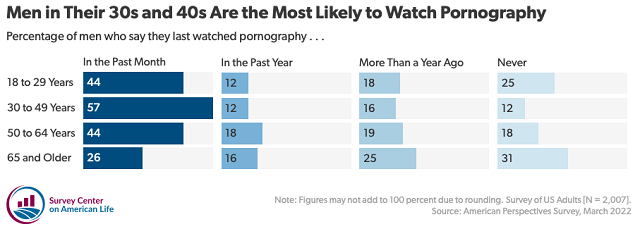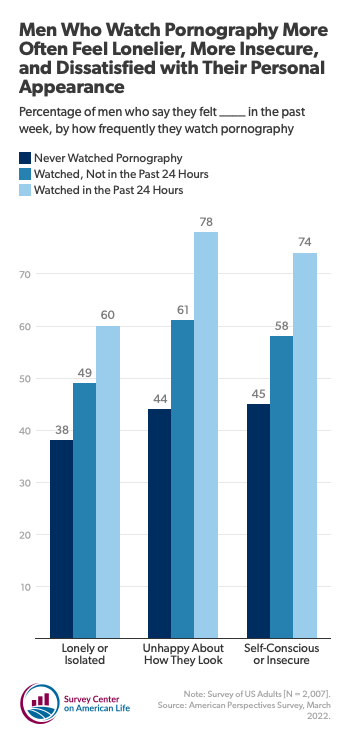Highlights
- Men who report having watched pornography recently—that is, in the past 24 hours—report the highest rates of loneliness. Post This
- 74 percent of men who report having watched pornography in the past 24 hours say they have felt self-conscious or insecure in the past week. Post This
- A majority (57 percent) of men ages 30–49 report having watched pornography in the past month, and 42 percent say they have watched it in the past week. Post This
In the internet era, online pornography has become ubiquitous. Roughly six in 10 (58 percent) Americans report having watched pornography at some point in their lives, including more than one in four (27 percent) who have watched it in the past month. But there are massive gender differences in the consumption of pornography. Men are four times more likely than women to report having watched pornography in the past month (44 percent vs. 11 percent).
Men in their 30s and 40s report the most frequent use of pornography. A majority (57 percent) of men ages 30–49 report having watched pornography in the past month, and 42 percent say they have watched it in the past week. In contrast, 44 percent of young men and only 26 percent of senior men say they have watched pornography at some point during the past month.
Even if most Americans do not report engaging in this activity regularly, exposure to pornography is much more common today than it was in the past, particularly among women. More than eight in 10 (81 percent) women age 65 or older say they have never watched pornography, while less than half (44 percent) of young women say the same.

The Pornography Problem
The widespread availability of pornography online has made it easier to access. Most young adults say they have watched pornography at some point in their lives. But regularly watching pornography is associated with a number of negative social outcomes and personal experiences. This association is more pronounced for men than it is for women.
Men who report having watched pornography recently—that is, in the past 24 hours—report the highest rates of loneliness. Six in 10 (60 percent) men who watched pornography in the past 24 hours say they have felt lonely or isolated at least once in the past week. In contrast, fewer than four in 10 (38 percent) men who have never watched pornography and 49 percent of men who have watched it but not in the past 24 hours say they have felt lonely in the past week.
Americans who regularly watch pornography also report more frequent feelings of dissatisfaction with their personal appearance. Again, this effect is particularly notable for men. Nearly eight in 10 (78 percent) men who have watched pornography in the past 24 hours say they have felt unhappy about their appearance in the past week. Less than half (44 percent) of men who have never watched pornography and 58 percent of those who have not watched it recently say they have felt unhappy with how they look in the past week.
Men who watch pornography regularly are also more likely to report they frequently feel insecure: 74 percent of men who report having watched pornography in the past 24 hours say they have felt self-conscious or insecure in the past week. Only 45 percent of men who say they have never watched pornography say the same.

Pornography may also contribute to men feeling less satisfied with their sex lives. Only about a quarter (26 percent) of men who report having watched pornography in the past day say they are completely or very satisfied with their sex lives, compared to 41 percent of those who say they have never watched pornography.
The findings here are not conclusive evidence that pornography is causing these problems. Rather, these results show a strong relationship between pornography use and a variety of negative social conditions and circumstances. But it’s quite plausible that Americans who are lonelier or feel less confident in their appearance more readily turn to pornography than do those with stronger social ties and greater self-confidence. Results could also be due to confounding variables—such as age, gender, or social class—that are associated with both pornography use and these particular outcomes.
To account for these potentially confounding variables, we ran four separate logistic regression models predicting the following: feelings of loneliness, feelings of personal insecurity, satisfaction with one’s appearance, and satisfaction with one’s sex life. We find that pornography use remains a significant predictor in each of the four models, even when controlling for important personal characteristics such as age, race and ethnicity, gender, marital status, income, and education.
Daniel A. Cox is the director and founder of the Survey Center on American Life and a senior fellow in polling and public opinion at the American Enterprise Institute. Beatrice Lee is a research assistant at the Survey Center on American Life. Dana Popky is a research assistant at the Survey Center on American Life.
Editor’s Note: This essay is excerpted with permission from "Politics, Sex, and Sexuality: The Growing Gender Divide in American Life," a new report from AEI's Survey Center on American Life.











